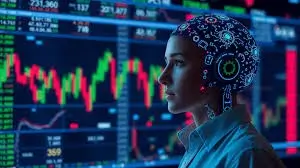The Australian forex landscape is undergoing a silent transformation. Artificial intelligence is reshaping the way the Australian dollar (AUD) is traded, enabling lightning-fast execution, sharper analysis, and a broader playing field for traders of all experience levels—from beginners in Hobart to seasoned professionals in Sydney.
Modern algorithmic systems are capable of processing thousands of data inputs in real-time—from geopolitical news to local economic indicators—and placing trades in a fraction of a second. What was once the territory of hedge funds is now open to everyday Australians.

AI Forex in Australia: Smarter AUD Strategies Rising ( Image Source: LinkedIn )
Quick Insights for Time-Poor Traders
Leading Australian brokers like Eightcap, eToro, and IG Group already offer integrated AI tools. These systems are capable of identifying minor changes in market sentiment and responding to them instantly. Many local fintech startups are also crafting AI models tailored specifically for the AUD market—able to catch early signals like Reserve Bank announcements or changes in commodity-driven sentiment.
A Day with an AI-Powered Trader
Picture this: a data-savvy forex trader in Sydney logs into her platform each morning. Instead of manually scanning charts, she relies on her AI-driven trading bot, which has already processed overnight news, identified a likely move in the EUR/AUD pair, and generated a low-risk trading signal. She finalises the trade with a single click. It’s efficient, emotion-free, and entirely data-driven.
Further south in Melbourne, an institutional trading desk uses reinforcement learning algorithms that adapt in real-time—adjusting tactics based on evolving technical indicators and volatility. The goal? Minimise drawdowns and maximise consistent returns.
Why It’s Gaining Ground Now
The forex market operates 24/7. But humans can’t. AI bots fill that gap by providing round-the-clock market surveillance—reacting to central bank updates, oil price movements, or sudden shifts in global risk sentiment. Their rapid response and accuracy often lead to narrower spreads, quicker trade execution, and improved returns.
For individual traders, AI levels the playing field. For professionals, it scales strategy. For the wider economy, it boosts liquidity and tempers extreme market swings.
How AI Is Transforming Forex Trading
1. Smart Algorithms and Auto Execution
Today’s bots go beyond traditional rule-based Expert Advisors. They adapt to changing market regimes and update their trading parameters automatically—no need for constant human intervention.
2. Real-Time Sentiment Detection
AI scans financial headlines, social feeds, and sentiment indexes to gauge market mood. If global markets turn risk-off following a trade announcement or China’s data release, AI bots will often be first to act.
3. Risk Management
Advanced AI systems now calculate optimal stop-losses, size positions based on real-time volatility, and avoid poor liquidity zones. The result? Better protection against unexpected swings.
4. High-Frequency Tactics on a Retail Scale
While full-scale high-frequency trading (HFT) is still dominated by major players, Aussie brokers now offer toned-down HFT models that allow traders to take advantage of fleeting price discrepancies and minor shifts.
Aussie Brokers and Fintechs at the Forefront
- Eightcap (Melbourne): Offers AI-driven tools, all under ASIC’s regulatory eye.
- eToro & IG Group: Provide sentiment-based investing, algorithmic features, and robo-advisors fine-tuned for AUD trades.
- Fintech Innovators: Homegrown startups now embed machine learning models into trading bots, using frameworks like directional-change analysis and adaptive learning.
What Traders Are Saying
On platforms like Reddit and Australian trading communities, opinions vary. Some traders praise AI for helping them catch opportunities they’d typically overlook. Others highlight the importance of robust risk management measures.
“AI helps me find trades I’d miss—but don’t ignore risk, or it’ll backfire,” said one Brisbane-based user.
Experienced traders often treat AI as an assistant rather than a full replacement—automating the execution but maintaining control over strategy.
Regulation and Risk
The Australian Securities and Investments Commission (ASIC) presently caps leverage for retail trading at 30:1. This aims to protect individuals as AI trading tools become more accessible. Regulators are also keeping an eye on transparency—encouraging brokers to disclose performance history, ensure audit trails, and maintain ethical data use.
Looking at the Broader Impact
For professionals, AI is a strategic asset—enabling them to test complex theories, automate execution, and fine-tune models with less grunt work. For new entrants, it reduces the intimidation factor of forex trading by delivering clear, data-backed signals.
Overall, the rise of AI in forex contributes to improved AUD market dynamics—better pricing, increased trading volume, and more consistent liquidity.
Final Thoughts
AI forex trading in Australia has moved beyond theory—it’s now a practical reality. Whether it’s micro-trading bots spotting early trends or institutional systems crunching global data feeds, algorithmic trading is here to stay.
Keen to try? Start small. Choose a reliable Australian broker, experiment with demo bots, and always enforce strong risk management. The future of AUD trading is algorithmic—and now’s the time to join the movement.

